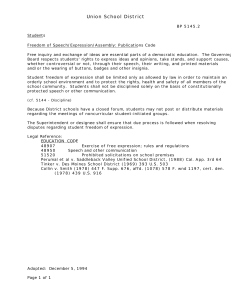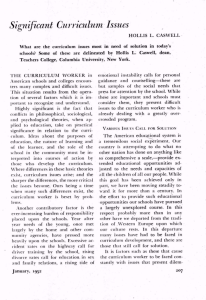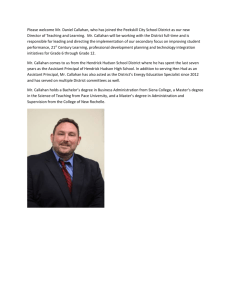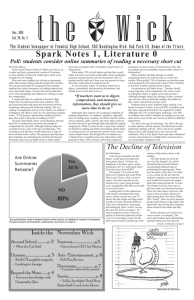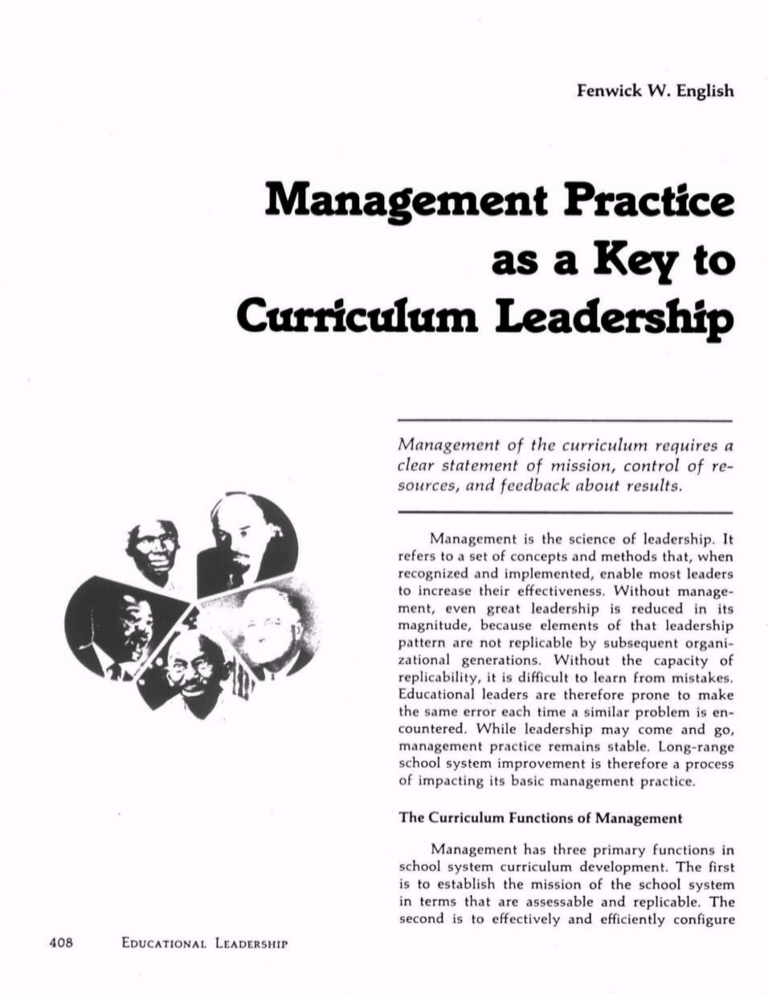
Fenwick W. English
Management Practice
as a Key to
Curriculum Leadership
Management of the curriculum requires a
clear statement of mission, control of re
sources, and feedback about results.
Management is the science of leadership. It
refers to a set of concepts and methods that, when
recognized and implemented, enable most leaders
to increase their effectiveness. Without manage
ment, even great leadership is reduced in its
magnitude, because elements of that leadership
pattern are not replicable by subsequent organi
zational generations. Without the capacity of
replicability, it is difficult to learn from mistakes.
Educational leaders are therefore prone to make
the same error each time a similar problem is en
countered. While leadership may come and go,
management practice remains stable. Long-range
school system improvement is therefore a process
of impacting its basic management practice.
The Curriculum Functions of Management
Management has three primary functions in
school system curriculum development. The first
is to establish the mission of the school system
in terms that are assessable and replicable. The
second is to effectively and efficiently configure
408
EDUCATIONAL LEADERSHIP
the resources of the system to accomplish the
mission. The third is to use feedback obtained to
make adjustments in order to keep the mission
within agreed-upon costs.
The purpose of a school system's curriculum
is to indicate what results (pupil learning) are de
sired, as well as what content will be taught. As
such, curriculum deals with scarce resources in
much the same manner as a budget. The curricu
lum is a response to the limited formal schooling
time a vailable for learning to occur, and the al
most limitless supply of information or content
that could be included in any school program. In
addition, the curriculum is an o rganizational re
sponse to reduce the level of variance in both con
tent and time, laterally (among the same grade
levels) and horizontally (across grades). This has
been the historic function of the curriculum guide.
via teaching. If the teacher ignores the curriculum
guide, or if the guide is so vague as to permit
many equally valid interpretations of the teaching
that is desired, the curriculum may have both a
high task or content variance, and a high time
variance. T ime on task represents the two most
important variables with which a curriculum must
deal. High levels of variance of task and/or time
may mean the curriculum is not an effective or
ganizational focusing tool for the work of those
in the schools. The outcome may be high levels of
content saturation accompanied by pupil boredom,
and/or critical gaps in student learning because
the curriculum is not being taught. It may also
portend the mismanagement of the school sys
tem's scarce resources.
Barriers That Impede Effective
Curriculum Management
The Manageable Elements of Curriculum
School curriculum contains at least three com
mon and manageable elements. For something to
be manageable it must be capable of being iden
tified and isolated, and it must be responsive to
directions. The first manageable element is a c ur
riculum boundary, which serves as the criterion
for making inclusion/exclusion content-related
decisions. The second element is the planned level
of repetition, o r time allocation, of selected con
tent. The third element is s equence of content.' A
curriculum sequence is a statement of the manner
in which t nsks a re to be introduced or arrayed
within given time segments.
The curriculum is designed to improve upon
randomness or chance that desired and/or re
quired learning will occur. The curriculum is a
causative agent. It is a purposive tool. It also is
the school system's major vehicle to achieve some
economy of scale in the acquisition and use of its
resources. It is the linkage between teaching and
learning from the system's perspective.
There are two kinds of curriculum in the
schools the one in the curriculum guide and the
one in the classroom when the teacher shuts the
doer. They are not always the same. If the learner
never encounters the curriculum in the guide,
then all of its balance, logic, and sequence make
little difference. For the learner, the real curricu
lum is the one in the classroom that is experienced
There are in most school systems today a
number of common traditions and assumptions
that block effective management of the curricu
lum. I will review them according to how they
influence the performance of the primary func
tions of curriculum management.
Mission
One factor preventing effective curriculum
management is that schools do not state their
missions in specific terms. The arguments or as
sumptions most commonly blocking mission spec
ificity are those that center around measurement,
consensus regarding the goals or ends of educa
tion, and those that pertain to the ideology of
management being used in education.
The argument regarding measurement is that
all of the aims of education cannot be measured,
leaving educators and citizens only with those
that are most easily measured, that is, concrete
bits of information. Such an emphasis, it is
argued, leads to rote memory and pupil regurgitation. The measurement debate is mostly an edu
cator hangup. Once measurement is broadly de
fined as including all four scales of measurement,
1 George J. Posner and Kenneth A. Strike. "A Cate
gorization Scheme for Principles of Sequencing Content."
Review of Educational Research 4 6(4) :665-90; Fall 1976.
MARCH 1979
409
including the nominal, ordinal, ratio, and interval
scales, all of the aims of schools can be measured. 2
While it is true that creativity, love, curiosity, and
other "affective goals" cannot be measured on a
ratio or interval scale, they can be assessed on a
nominal or ordinal scale. Measurement is not an
absolute process. It varies with the thing being
measured.
The area of consensus regarding educational
goals or outcomes is a second common problem.
While a heterogeneous society does indeed pos
sess conflicting goals for its institutions, there are
also areas of broad agreement. Ten years of the
Gallup Polls in education reveal a rather remark
able record of public consensus about what the
schools should do and be. Educators tend to have
more problems than citizens since they are per
sonally linked to jobs that support such purposes
or goals. In times of program and organizational
retrenchment, job security and internal system
politics have often clouded a rational discussion
by educators about the outcomes of education.
There are those who find the language of
management unduly restrictive, for they regard
specificity as a kind of vice. They argue that if the
outcomes of education become too specific, they
are trivialized. What they apparently won't admit
is that specificity may reveal that we have no
means to fulfill the expectations of our publics for
the students we must educate. In simple words,
we do not know how we can do any better job
than we are now doing. 3
The continuing dodge into ambiguity by
some educators merely exacerbates the problem
public education is now encountering with main
taining a modicum of public confidence. Rather
than face and resolve the problem of standards
and testing, we are prone to attack the symbols
of our discomfort. Fuzzy language based on ro
mantic notions of organic child development re
quires no professionals. It certainly requires no
curriculum. Effective results in a nonsystem are
merely a combination of good fortune, genetic
endowment, benevolent situations, and benign in
tervention.
Resources
A second barrier to curriculum management
is failure to configure resources effectively and
410
EDUCATIONAL LEADERSHIP
efficiently. Arguments used to defend current
practice pertain to a school unit-based manage
ment model of curriculum development and co
ordination, and the lack of absolute verification
of the relationship between teaching and learning.
School system curriculum management has
proven to be difficult and illusive. Some critics and
educators have all but given up on even trying to
improve education by dealing with the system as
a whole. 4 They apparently have accepted the myth
that a nonsystem is preferable.
A school system is the sum total of its inde
pendent parts. The reason a system organization
is created is to ensure a greater level of control
over the separate and independent parts. By so
doing, greater effectiveness and efficiency is
achieved by combining resources. Random re
sponses that do not lead to better results can be
eliminated or reduced. A curriculum is an opti
mizing process in this respect.
Most school systems are not systems at all.
They do not respond holistically. It is impossible
to move them with directions that mean shifts in
content or procedure very rapidly, if at all. Such
systems are confederations of classrooms strung
together like beads around graded schools held
together very loosely by curriculum prescriptions,
traditional nostrums and practice, word of mouth,
vague board of education policy pronouncements,
union contractual clauses, and systemwide tests.
For any organization to be classified as a sys
tem, it must have a clear unambiguous mission,
a purposive design to attain the mission, and
possess the ability to issue directions to change
its sum aggregate behavior based upon feedback.
Unless a school system, as a system, can change
its aggregrate behavior, no improvement is pos
sible overall. Sympathetic teaching is not enough.
A system that cannot respond as a system cannot
be controlled. It is out of control. Such systems
are educationally bankrupt.
2 Sec: Fenwick W. English and Roger Kaufman.
Needs Assessment: A Focus for Curriculum Development.
Washington, D.C.: Association for Supervision and Cur
riculum Development, 1975. p. 7.
n See: Nancy Hicks. "Public Education: What's Hap
pening to the Children?" B lack Enterprise 9 (2) :32; Sep
tember 1978.
4 William Raspberry. "What? Teaching Writing?"
Washington Post, S eptember 6, 1978.
The extreme decentralization of curricular
practice in most school systems today stands as a
major barrier to any improvement of system cur
riculum. A curriculum guide provides a set of
references for the teacher. It establishes the basic
parameters of the content. Yet the current range
of content and time options open to teachers in
such systems introduces the possibility of such
extreme variances occurring as to negate potential
instructional effectiveness, in addition to assum
ing significant resource diseconomies^ The cur
rent state of curriculum management is a kind of
tacit anarchy. To defend such practice as the
"best" of all possible alternatives is to abandon
the purpose of a system and to excuse the current
mode of management from a serious and sus
tained search for improvement. Schools are not
school systems.
The curriculum assumes a viable and positive
relationship between teaching and learning. While
a "proven" relationship between the two has not
yet been developed in the confines of a research
model/1 the pragmatic relationship in the school
ing context is undeniable.
Teaching is not an end in itself; the facilitation
of learning is the only proper end of teaching. Even
though the failure of pupils to learn does not neces
sarily indict the competence of the teacher, learning
is still the only feasible measure of teaching rneri.t. 7
The analysis of the effective and efficient de
ployment of resources to attain a specific mission
is always a relative one, never an absolute calcula
tion. To require a "proven" relationship between
the two before the management process can be
applied is to jeopardize the existence of schools,
public or private, since virtually all activities are
riveted to this one. This would include collective
bargaining agreements with teachers and their
unions. Teacher salaries and fringe benefits are
assumed to make a difference in the educational
process. It seems reasonable that management
would be able to make use of the same assump
tion.
Feedback
A third way schools fail to practice curricu
lum management is to neglect systematic use of
feedback. The current dialogue and debate re
garding the efficacy of testing within the educa
412
EDUCATIONAL LEADERSHIP
tional profession has neither dimmed public en
dorsement of tests, nor put a stop to the larger
minimum competency movement of some 35
states. 8 Tests can provide useful information
about the extent to which some objectives of a
school system have been attained by students.
They can serve a management function without
punitive or negative consequences occurring to
students who do not perform well on them. 9
Without some indication of results in terms of
student learning, school systems have precious
little information upon which to correct their
aggregate behavior as a system.
Mission statements and tests such as those
found in minimum competency legislation will
not by themselves raise learning in the schools.
But standards in the form of objectives can bring
about some improvement in the ways schools de
liver their services as a system. Test results are
useful only to the extent that they serve as indi
cators, but they can spur a school system to
change direction and thereby accomplish an in
creasing array of purposes.
Opponents of the ideology of management
usually cite Raymond Callahan's classic school
administration expose, The Cult of Efficiency, 10 as
evidence against current efforts to utilize manage
ment thinking in education. Callahan's review of
the slavish application of techniques concerned
only with reducing costs in schools misses the
boat with the accountability and minimum com5 Fenwick W. English. Q uality Control in Curriculum
Development, A rlington, Virginia: American Association
of School Administrators, 1978. 62 pp.
15 David C. Berliner. "Impediments to the Study of
Teacher Effectiveness." l ournal of Teacher Education 27
(1):5-17; Spring 1976.
7 David Ausubel. "A Cognitive-Structure Theory of
School Learning." In: L. Siegel, editor. I nstruction: Some
Contemporary Viewpoints. S an Francisco: Chandler Pub
lishing Company, 1967. p. 212.
8 For a review of some states and city school systems
using minimum competencies, see: William Grant.
"Measuring How Much High School Students Know."
Detroit Free Press, J uly 23, 1978.
9 Frank L. Steeves and Fenwick W. English. Sec
ondary C urriculum for a Changing World. Columbus,
Ohio: Charles E. Merrill, 1978.
10 Raymond E. Callahan. E ducation and the Cult of
Efficiency: A Study of the Social Forces That Have Shaped
the Administration of the Public Schools. Chicago: Uni
versity of Chicago Press, 1962.
petency legislation." Citizens and legislators to
day are concerned about results as well as costs.
It is possible to construct cheap educational pro
grams without being effective. This was Callahan's point, but it is often incorrectly applied to
contemporary problems.
Management today is first concerned with
results, and particularly those peculiar to the en
terprise of education. Schools are not factories. A
study of school management would reveal that
many of the solutions educators have historically
selected and implemented are those that have
limited schools from becoming more humane
places. 12 Effective application of management
practice would be to identify poor practices and
eliminate those that are contradictory to the re
sults desired. If humane schools are a prerequisite
then they are too important to be left to chance.
The implementation of sound management prac
tice ensures that schools improve considerably
upon good fortune as the only agent of quality
control. 13
There can be no denying that leadership is
required for management practice to be improved.
Long-range effectiveness and efficiency of school
systems must depend upon improvement of man
agement to impact organizational behavior. While
management may not be charismatic, it is within
the process of institutionalization of better and
more effective curriculum practice that any kind
of sustained aggregate improvement or "deep
change" will take place. The cornerstone of effec
tive management moves beyond an acceptance of
serendipity as a measure of adequacy.
11 Sec: Leon Lessinger. "Wiles and Lessinger Clash
on Effectiveness/Efficiency." A ASA Professor l (4):2-5;
Fall 1978.
'-Fcnwick W. English. "Matrix Management in Edu
cation: Breaking Down School Bureaucracy." E ducational
Technology 1 7(l):19-26; January 1977.
1:1 Fenwick W. English. "What's Ahead in Curricu
lum?" A ASA School Administrator 3 5(11):18-19; Decem
ber 1978.
Femvick W. English is
a Manager with Pent,
Marwick, Mitchell and
Co., Washington, D.C.
The Schools Rote
os Moral /"urhority
Staff Development: Staff Liberation
Charles W. Beegle and Roy A. Edelfelt, editors
$6.50(611-77106)
This publication presents a variety of ways of con
ceptualizing and organizing the staff improvement
function, emphasizing the "liberation" and selfgrowth of individuals.
The School's Role as Moral Authority
R. Freeman Butts. Donald Peckenpaugh,
and Howard Kirschenbaum
54.50(611-77110)
Companion essays on moral education analyze a
number of contradictory arguments regarding values
education, contrast alternative teaching strategies,
and review a number of ongoing programs.
City__
-Zip-
No. of Copies
_._Staff Development: Staff Liberation
(611-77106, $6.50. 124 pp., 1977)
___The School'1 Role as Moral Authority
(611-77110, $4 50. 80 pp.. 1977)
Enclosed is my check payable to ASCD Q.
Please bill me Q
Postage and handling extra on all billed orders. AH orders totaling
$1000 or less must be prepaid by cash, check, or money order.
Orders from institutions and businesses must be on an official pur
chase order form. Discounts on orders ot the same title to a single
address 10-49 copies, 10%; 50 or more copies, 15%.
Return to
Association for Supervision and Curriculum
Development—Box 342
1701 K St., N.W.. Suite 1100
Washington, D.C. 20006
MARCH 1979
413
Copyright © 1979 by the Association for Supervision and Curriculum
Development. All rights reserved.

